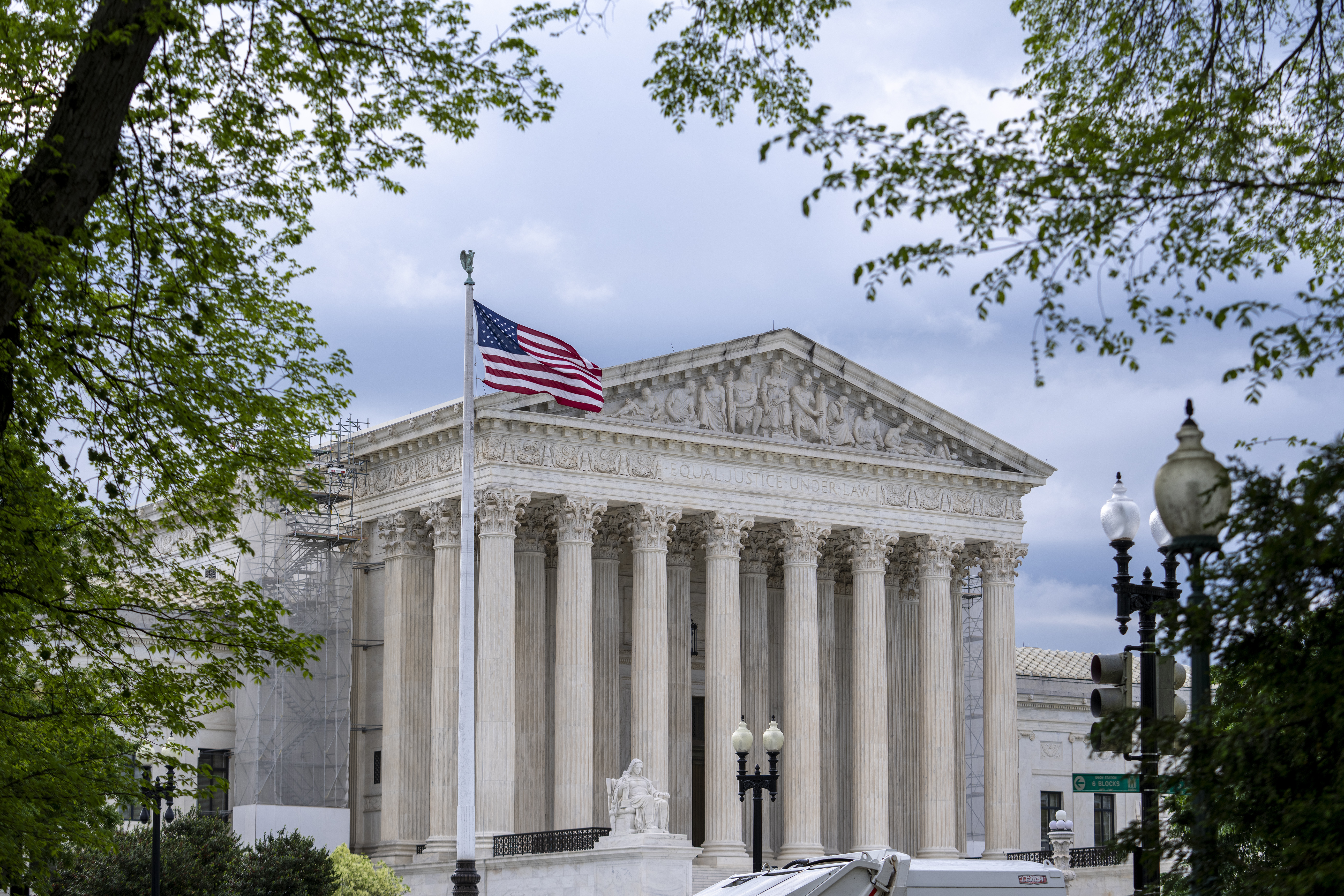
When student loan repayments began last October, Rachel Grace was faced with a painful financial choice: start making payments or drop her health insurance coverage. She chose her loans and has since been crossing her fingers that she stays healthy.
“We’re already all pinching pennies. It was that big health insurance cost every month that I thought was the one place where, at least for now, fingers crossed, I can do without so that I can tackle this loan payment,” said Grace, who is 39 and works in marketing communications in Nebraska. “Of course, that could change in an instant, and that’s scary.”
But this week, Grace got the news she'd been in financial limbo over for months — her federal loans were being forgiven, wiping out a roughly $300 a month payment, under a Biden administration plan to clear the loan balances for those who have been making payments for at least 20 years.
After the Supreme Court rejected President Joe Biden’s sweeping debt forgiveness proposal and a Covid-era pause on student loan payments expired, millions of borrowers have been faced with tough financial choices and a web of new debt relief plans and administrative delays that have left many in limbo over if and when their debt will be forgiven, said student debt counselors and borrowers.
Get New England news, weather forecasts and entertainment stories to your inbox. Sign up for NECN newsletters.
“The road to hell is paved with good intentions,” said Betsy Mayotte, the head of the Institute of Student Loan Advisors, a nonprofit that provides free student loan advice. “I have seen a significant number of borrowers who have had relief, but on the flip side, because everything has had to happen really fast, it’s also caused some confusion for borrowers and it’s caused some bumps in the road.”
But the effects of that relief are starting to be felt by more borrowers like Grace, something the Biden campaign is working to capitalize on in the months leading up to the election.
Biden’s efforts to provide relief to student loan borrowers has been a top policy priority during his time in office. The Biden administration says it has provided student debt relief to 4.6 million Americans through more than two dozen different programs, including fixes to a pre-existing loan forgiveness program for public service workers, erasing debt for borrowers defrauded or misled by their school and expanding debt forgiveness for people with disabilities.
U.S. & World
Last month, Biden proposed additional plans he said would reduce or erase the student loan debts for millions more as early as this fall, an Education Department official said.
But many borrowers have struggled to make sense of what all those initiatives mean for them or see the full benefits as some programs continue to be implemented, said Robert Farrington, who counsels student loan borrowers and is editor-in-chief of the website The College Investor.
“There is a firehose of announcements and new programs and so many various nuances to all of these things. There’s different repayment plans, there’s different forgiveness programs, different lawsuits,” said Farrington. “It’s hard for borrowers to even know what applies to them. It’s so confusing.”
Education Department officials say borrowers who believe they are eligible for debt relief but haven’t received it yet should contact their loan servicer or the department ombudsman’s office.
Amid the confusion, the Biden campaign has been seeking to show the real-world impact on borrowers who have received debt forgiveness in its pitch to voters for a second term, a campaign official said. Biden and other top administration officials have fanned out across the country to tout their efforts.
In one instance, Biden visited the home of a former school principal in North Carolina who had $90,000 in debt erased under the public service loan forgiveness program, a decades-old program the Biden administration has made changes to in order for more borrowers to qualify. A TikTok video of the visit made by the man’s son got millions of views.
Still, the majority of voters have said they disapproved of Biden’s handling of the student loan issue — with 44% approving, making it Biden’s strongest area among registered voters, according to an NBC News poll last month. In a separate poll by the Harvard Institute of Politics, just 39% of voters under age 30 said they approved of the job Biden has done on student loans. But like in the NBC poll, it was a higher approval rating than on other key issues.
The campaign official said it will take more time and aggressive messaging to get the attention of voters, whom the campaign believes are not yet paying close attention to the election. The campaign is also seeking to contrast Biden’s policies with those of former President Donald Trump, who has opposed student debt relief programs and actively sought to eliminate funding for them while president.
Rep. James Clyburn, D-S.C., a close Biden ally, said he expects tens of thousands of additional borrowers to see debt relief ahead of the election as Biden’s programs continue to be implemented, giving the campaign more opportunities to highlight the contrast with Trump’s opposition to such programs, he said.
“Who do you want to put in charge of that program?” Clyburn said in an interview with NBC News. “The guy who refused to implement it?”
Biden “has implemented the program that [Trump] tried to get rid of,” Clyburn continued.
But for the millions of borrowers not eligible to have their debt cleared, they have been required to make payments since October, creating an additional financial strain for many. Around 40% of borrowers who have resumed payments said they are cutting back on spending while 29% said they were reducing the amount they were saving, according to a University of Michigan survey released in January.
The survey found that borrowers who had lower incomes, less education and weaker income prospects were more likely to increase their use of credit to maintain their spending amid the resumption of loan payments.
Others have opted not to make their payments. Around 64% of borrowers who had payments due were current on their student loan payments as of the end of December, according to the Department of Education.
The Biden administration has said it will hold off until this fall on enforcing the harshest penalties for nonpayment, like reporting delinquent borrowers to credit rating agencies and using forced collections.
Mayotte said a number of borrowers she works with have been holding off on making their payments because they can’t afford them or have opted to use the money to pay down higher-interest debt or to invest in high-yield savings or investing accounts until the administration’s nonpayment penalties kick in.
Once that happens, the wider implications of the restart in payments could be felt, but so far it hasn’t appeared to have had a significant impact on the wider economy, according to an analysis by Wells Fargo.
For Grace, who took out around $40,000 in private and federal loans to attend a four-year public university in 2003, she said her monthly loan payments have been a heavy burden on her finances since she first started making them more than a decade ago.
At the start of her career, her loan payments amounted to more than 15% of her take-home pay, preventing her from being able to build up an emergency fund for unexpected costs, like a car repair, and causing her to rack up credit card debt. For years, she said, she had to work a second job on the weekends to cover her expenses.
But her financial picture drastically changed during the pandemic when the Covid payment pause began. Without that monthly loan payment, she said she was able to start building up her savings and pay off credit card debt. Eventually, she was able to buy her first home.
“Prior to that pause, things were pretty dire,” Grace said. “And so this gave me the opportunity to really finally start to catch up. It’s amazing what happens when you don’t have hundreds of dollars month after month going to this.”
Grace said she knew the payment would eventually restart and didn’t take on any additional monthly expenses. But with inflation driving up the cost of everything from groceries to utilities, the resumption of the payment was an even bigger strain on her budget than before.
When it came time for the payments to restart in October on the $10,000 she still owes, Grace was also making a decision about signing up for her employer’s health insurance plan for 2024. She opted to take the risk of going without health insurance to continue making progress on paying down her debt.
With her federal loan payment now forgiven, she knows what she will do with the extra next month.
“I won’t be going to Target with that money, I won’t be going on vacation,” she said. “I will be enrolling in health insurance.”
This story first appeared on NBCNews.com. Read more from NBC News here:



